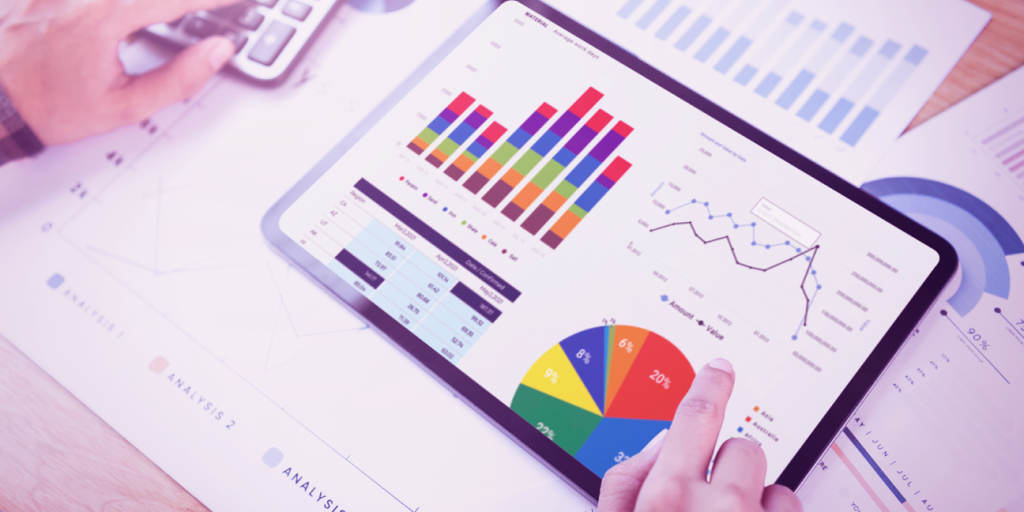Table of contents

SEO activities are a staggered process, quite complicated, depending on the purpose and type of business our client is doing. So, as we can guess, there is no one simple recipe for a good SEO report. We need to take into account a number of factors that will ensure that after receiving our report, the client will be accurately informed about the results and the course of action and will feel that he realistically knows exactly what he is spending his marketing budget on.
These are a few elements to consider when creating an SEO report:
1. Selecting the form of presentation of the SEO report
Let’s start with the basics that is, in what form we will present our report to the client, and there are several variants here:
- The first and most obvious is a PowerPoint presentation, which allows us to easily present all the results we want to present in a visual way, along with a commentary appropriate to them. In addition, such a presentation uploaded to Google Drive or SharePoint will simultaneously be available to more people with current changes.
- The second option is to create reports in Excel. This is a useful solution when we need to report a large amount of data that would not fit in the presentation in a clear and visually appealing way (for example, many keywords with their positions). However, it is difficult to create a clear and attractive report using only Excel, it is better to use it as an appendix expanding our main report.
- A custom tool/panel for customers—Large companies often decide to create their own tool, with which, after logging in, the customer himself can check an interactive report, to which data is automatically downloaded from external sources via API. This is an attractive solution; however, it is costly to create and later maintain.
- An intermediate option between creating report presentations and an in-house tool is Google Looker Studio, a free tool that allows you to create reports based on data automatically pulled from other tools using an API. Looker Studio reports created correctly are visually appealing and clear presentations of data, conclusions, and results.
Using Looker Studio, however, requires some knowledge and practice so that the reports we create work automatically, in the right way, and are readable. If we want to use Looker Studio in our daily work, it is worth taking advantage of training or tutorials available on the web so that we do not get discouraged.
An unquestionable advantage of Looker Studio is that once prepared, the report (if done correctly) always refreshes itself, so there is no need to download the data manually every month. This allows you to significantly reduce the time of its preparation. All charts and tables generated by us will update themselves after changing the date to the current one.
Although the Looker Studio tool itself is free, it is worth remembering that the manufacturers of some commercial tools (other than Googling, of course) from which we want to download data require the user to purchase a higher package in order to freely use the data via the API.
We can send our clients and colleagues a link to the report created in Looker Studio or grant them access via email address, granting different permissions (to view or edit). If necessary, the report can also be downloaded as a PDF.
2. Base-a-report-on-data-but-present-only-that-will-bring-something-to-the-customer

When conducting SEO activities in large-scale and large-scale projects, we have access to a huge amount of data, which is more or less relevant, depending on what marketing goal we want to achieve. It goes without saying that the report must be based on reliable data from the tools, and any conclusion we present must be supported by numbers. However, in wanting to present as much information as possible, we can easily fall into the trap and try to give them everything instead of condensed knowledge that will be of value to the customer. Obviously, this is not the way to go, as we will not keep the customer’s attention. When building a report, we should focus first and foremost on data that will show our client the level of achievement of his goals.
For example, if the client’s main goal is to build brand awareness, we should first show him data on what content we managed to publish internally and externally, how his organic visibility and traffic from branded phrases increased, and indicate search trends, e.g., from Google Trends.
If, on the other hand, the client’s most important goal is lead acquisition, we should focus on the number of leads, the conversion rate, and the analysis of the sessions that led to the lead’s acquisition or not. The organic visibility data will be a secondary issue in this case.
For online stores, sales data, conversion rate, abandoned shopping carts, session duration, number of sessions, number of new users, shopping cart height, etc. will be of primary importance.
For a client running an educational business based on content creation, the most important data will be site traffic, visibility for general and long-tail keywords, session duration, and the „readability” of articles.
There are as many variations for choosing the most important data as there can be SEO goals. The above presented are only examples. It is worth keeping in mind all the main and side goals that the client has set for us at the beginning of the cooperation and always planning the structure of our report based on them.
The most important data will be traffic, the visibility of general and long-tail keywords, and the „readership” of articles.
3. Choose the tools from which you will get data
Before you start preparing a report, decide which tools you want to present data from and stick to them in the following months. This is especially important because different tools use different data collection methods, so results between them may differ. Comparing results from period to period can, therefore, be problematic if the numbers come from different sources.
Types-of-tools-worth-accessing-to-create-a-complete-SEO-report:

– tools for analyzing website traffic (such as Google Analytics, Matomo, etc.)
– tools for analyzing a site’s organic visibility (e.g. Google Search Console, SemRush, Ahrefs, Senuto)
– tools for backlink profile analysis (e.g., MajesticSEO, Ahrefs, Google Search Console)
– competitive analysis tools (e.g., Senuto, SemRush, Ahrefs)
– tools for tracking organic keyword positions (e.g., Senuto)
– tools for technical analysis of the site (e.g. Google Search Console, Screaming Frog, Page Speed Insights)
4. Pay-attention-to-form-of-statement-present-concretes
A good report is not just about numbers, the most important part is to summarize them and present valuable conclusions that will improve the project and its performance in the future. Remember to:
- When you present numbers, never leave them unmentioned, the client needs to know why they are in the report and what makes them relevant to our project
- Present the conclusions with a proposal of actions that follow from them, e.g. if the conclusion of the data we present is that organic traffic has dropped significantly, provide a potential cause right away and information on how this trend can be reversed
- Be convincing – support all conclusions and proposals with numbers or examples from the market, use logical arguments and facts
- Be credible – if you propose a change in the project or a completely new solution for the client use, for example, case studies of similar clients
- Pay attention to the language you use when writing information in the report, try to use phrases that denote certainty, not just a subtle probability, e.g. „the effect of such actions WILL be an increase in organic visibility”, instead of „the effect of these actions MAY BE an increase in organic visibility”
5. Always provide data sources
If you present any data from your own or external tools in your report, always cite the source of the data. This will build the credibility of the information you present in the eyes of the person reading the conclusions.
6. Start the report with general conclusions

This is an element that will appear at the beginning of the report, but for obvious reasons, it will be the last thing created in the entire reporting process (without analyzing the data, we won’t create conclusions, after all). It’s a good idea to present general conclusions in the form of concise points summarizing a given month, along with the actions that result from them in the next month. Such information can be included as the first page of our report and as the body of the email in which we send our report. In this way, a customer who does not have time at the moment to read the materials we send will know what the current situation is.
7. Data about organic traffic and conversions present always in chart or table form
If you adopt an inadequate form of data presentation, no one will pay attention to it, and the conclusions regarding it will go unnoticed, so always present any numerical data in a visually appealing way.
The best solution, of course, will be charts and tables, which will clearly show the trend of change in performance over time. Remember to try to avoid red and orange colors on charts, as they are always associated with declines and, in the subconscious of the person reviewing the report, may suggest the presence of a big problem even if it is not there.
The best way to do this is to use red and orange.
Under each chart and table always include a concise commentary summarizing what we can see on them. Present information about increases and decreases both numerically and as a percentage.
Take a look at the figures and the percentages.
8. Present external content published in a given period
For clients with multiple simultaneous activities, they may not know which of the publications appearing on the web are the result of SEO activities, so it is worth presenting them in the report along with url addresses and brief information about what they concern.
Also include the current state of your link profile, i.e. the number of domains and url addresses pointing to your site, also preferably in the form of a graph to show the change over time and, for example, the increase in domain rating.
9 Add-competitor-analysis
Commercial SEO tools show us approximations of your competitors’ performance, show the organic visibility, estimated traffic and domain rating of your competitors in the report, preferably in a graph, so that you can see the trends of their changes over time.
Summarize all data presented about the competition with conclusions, indicate what their increases/decreases may be due to, what new activities they are conducting and which ones are worth considering in the client’s project.
10. Don’t forget about the technical aspects of the website
The report should also include information on whether the site is working properly in terms of technical aspects. First of all, whether there are any errors in Google Search Console that require intervention, whether the Google Page Speed score is maintained at a satisfactory level, and whether the Core Web Vitals are still met.
When any changes or corrections are necessary, include information about them directly in the report so that they do not go unnoticed.
11. Don’t-forget-the-summary
In the summary, reiterate the most important conclusions, indicate the actions you plan to take in the next month along with their schedule, so that the customer knows what to expect in the next accounting period and whether they should do something on their side themselves.
Summary
The SEO report is an important part of the SEO process primarily at the level of communication with the client and maintaining a good relationship. Search engine algorithms change frequently, we are operating in a very unstable environment, so it is extremely important that the client is kept abreast of the activities and that if there are any potential fluctuations (plus or minus), we are aware of what they are due to. This way we will be able to avoid any misunderstandings and our relationship with the client will be based on both parties’ understanding of the process.
Was the article helpful?
Rate our article, it means a lot to us!
Let's talk!
She has 11 years of professional experience, she started her career at the Emarketing Experts agency as a junior SEO specialist. In addition to website positioning, she was responsible for conducting 360° marketing projects as an Account Manager at They.pl. She worked for companies from the financial sector (Bank Millennium, Bank Meritum, Finai S.A.) and e-commerce (e.g. Black Red White, Autoland, Mumla). At Up&More, he is responsible for, among others, SEO projects for Panek Car Sharing, Amerigas, Interparking, H+H and Autoplaza.